2. 中国科学院大学, 北京 10004
2. University of Chinese Academy of Sciences, Beijing 100049, China
玉龙斑岩铜矿带是我国成矿远景最大的斑岩铜矿带之一(芮宗瑶等,1984),在该带中发育1个超大型,2个大型和2个中型斑岩铜矿床及20多个矿化点。这些超大型、大型斑岩型铜矿床的发现,引起人们的极大关注,国内多个单位对玉龙斑岩铜矿带开展了大量工作(李荫清等,1981; 芮宗瑶等,1984; 马鸿文,1989,1990; 丁朝建等,1990; 吕伯西等,1993; 唐仁鲤和罗怀松,1995; 王增等,1995; 张玉泉等,1998a,b,c; 陈文明,2001; 姜耀辉等,2006a,b; 梁华英等,2008,2009; Hou et al.,2003; Liang et al.,2005,2006,2009; Jiang et al.,2006,Li et al.,2012; 吴伟中等,2013; 何国朝等,2014; 邓军等,2014; Deng et al.,2014; 孙茂妤等,2015),加深了人们对玉龙斑岩铜矿带含矿岩体成岩成矿时代、岩浆源区特征及形成的构造背景等认识。玉龙斑岩铜矿带长约300km,已发现的主要矿床多集中于北段约50km长的范围内,主要有玉龙超大型斑岩铜矿床、马拉松多和多霞松多大型斑岩铜矿床,莽总和扎那尕中型斑岩铜矿床。玉龙斑岩铜矿带南段矿床规模不大,目前主要有各贡弄、色礼、色错、吉错,尊喜,马牧普、总郭等矿床(点)(图 1a)。过去研究工作主要集中在玉龙铜矿带北段,对玉龙铜矿带南段矿化岩体研究工作很少。玉龙斑岩铜矿带北段主要含矿斑岩锆石U-Pb年龄表明,成矿岩体形成时代由北往南逐渐降低(Liang et al.,2005),显示左行走滑构造控制特征(Liang et al.,2006; Campbell et al.,2014)。虽然前人已对玉龙斑岩铜矿带南段开展了一些同位素定年工作,但不同作者获得矿化岩体形成时代差异很大,如色礼岩体2个K-Ar年龄分别为101.6Ma(唐仁鲤和罗怀松,1995)和39.5Ma(张玉泉等,1987);马牧普岩体K-Ar年龄为96.8Ma(刘荣谟和赵定华,1981),而Rb-Sr年龄则为38.0~27.4Ma(唐仁鲤和罗怀松,1995)。显然,这些年龄不能反映岩体的形成时代。此外,玉龙斑岩铜矿带北段矿化规模大,而南段则矿化规模较小,目前对玉龙斑岩铜矿带南段和北段矿化规模差异控制因素等探讨不多。为了进一步分析玉龙斑岩铜矿带时空分布特征及分析玉龙斑岩铜矿带南段和北成矿规模差异控制因素,了解碰撞背景斑岩矿床成矿物质来源,本文分析了玉龙斑岩铜矿带南段色礼、马牧普及总郭矿化点矿化岩体锆石LA-ICP-MS U-Pb年龄、主微量元素特征及色礼岩体的锆石Hf同位素组成,并且对比玉龙斑岩铜矿带南段矿化点和北段超大型斑岩矿床含矿斑岩体岩浆源区特征。
2 玉龙铜矿带含矿斑岩体地质特征简介西藏玉龙斑岩铜矿带位于羌塘地体,三江构造中段,地处红河-哀牢山断裂系统的北延,受一系列NNW向断裂及走滑拉分盆地控制,其西侧为妥坝-芒康断裂,东侧是贡觉盆地及字嘎断裂(图 1a)。玉龙斑岩铜矿带长约300km,宽约15~30km,在该带中发育1个超大型(玉龙),2个大型(多霞松多和马拉松多)和2个中型(莽总和扎拉尕)斑岩铜矿床及20多个矿化点。玉龙斑岩铜矿带可分为南北两段,北段矿床由北往南依次为玉龙、扎拉尕、莽总、多霞松多及马拉松多等斑岩铜矿床,南段主要为一些矿化点,主要有各贡弄、色礼、色错、吉错、尊喜、马牧普及总郭等(图 1a)。
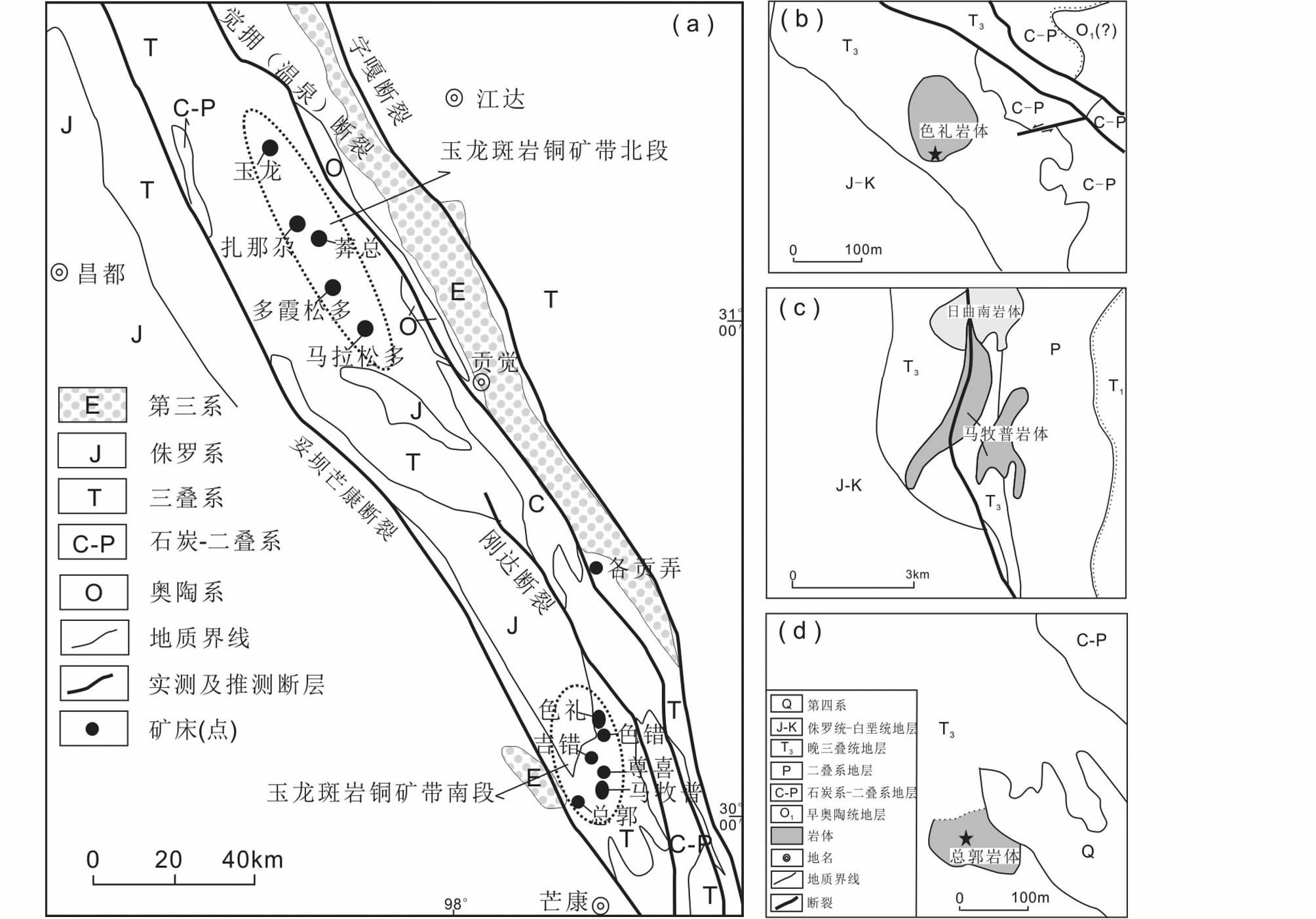
|
图 1 藏东玉龙斑岩铜矿带地质略图(a,据唐仁锂和罗怀松,1995; 张世铭等,2012)及玉龙斑岩铜矿带南段色礼二长花岗斑岩体(b)、马牧普正长斑岩体(c)和总郭石英二长斑岩体(d)地质略图(据西藏地质一队,1982①) Fig. 1 Simplified geological map of the Yulong porphyry Cu belt in eastern Tibet(a,modified after Tang and Luo,1995; Zhang et al.,2012)and simplified geological map of the Seli monzongranite porphyry pluton(b),the Mamupu syenite porphyry pluton(c),the Zongguo quartz monzonite porphyry pluton(d)in the southern Yulong porphyry Cu belt |
①西藏地质一队.1982.野外填图报告(内部资料)
色礼斑岩铜钼矿化点位于芒康县宗西区打拉乡,产于色礼背斜的核部,矿化斑岩体呈岩株状产出,地表出露的形态近等轴状,出露面积约0.009km2(图 1b);色礼岩体侵入晚三叠系的砂页岩中,岩体及围岩见绿帘石绿泥石化蚀变(马鸿文,1990)。色礼岩体呈灰白色,具斑状结构,块状构造(图 2a)。斑晶主要为斜长石和正长石,见少量的石英、黑云母和角闪石,基质主要由石英、长石组成,副矿物主要有磷灰石和锆石等(图 2d)。矿物组成及结构特征表明其为二长花岗斑岩。

|
图 2 玉龙斑岩铜矿带南段色礼二长花岗斑岩(a、d)、马牧普正长斑岩(b、e)和总郭石英二长斑岩(c、f)的手标本照片和显微照片 Bt-黑云母;Hbl-角闪石;Or-正长石;Pl-斜长石;Q-石英 Bt-biotite; Hbl-hornblende; Or-orthoclase; Pl-plagioclase; Q-quartz Fig. 2 Hand spicemen photographs and microphotos of the Seli monzongranite porphyry(a,d),the Mamupu syenite porphyry(b,e)and the Zongguo quartz monzonite porphyry(c,f)in the southern Yulong porphyry Cu belt |
马牧普金银铜钼矿化点位于芒康县老然区,矿化岩体产于吉措背斜南段西翼,主岩体分为东西两个部分呈岩墙形式产出,西面岩体平面上呈弯月状,出露面积约2.4km2,东面岩体为指叉状,出露面积约1.7km2(图 1c)。岩体侵入晚三叠系砂泥岩和二叠-白垩系砂砾中,围岩发生角岩化和绿泥-绿帘石化蚀变(马鸿文,1990)。马牧普斑岩体呈浅肉红色至灰白色,斑状结构,块状构造(图 2b)。斑晶主要为正长石和少量的角闪石、黑云母和石英,基质主要由正长石和他形石英和蚀变矿物组成,蚀变矿物主要为高岭土和绢云母,副矿物为锆石、磷灰石等(图 2e)。手标本观察和镜下鉴定结果表明其为正长斑岩。
总郭铜矿化点位于芒康县北部总郭村,矿化岩体呈岩株形态产出(图 1d)。总郭岩体的围岩是晚三叠统(T3)巴贡组紫红色砂砾岩及页岩夹凝灰岩和灰岩(据西藏地质一队,1982)。总郭矿化岩体为浅肉红色,斑状结构,块状构造(图 2c)。斑晶主要有正长石、斜长石、石英和角闪石组成,基质为石英、长石组成,副矿物主要为锆石和磷灰石等(图 2f)。矿物组成和结构特征表明其为石英二长斑岩。
3 分析方法色礼、马牧普和总郭斑岩矿床(点)含矿斑岩体的样品均采自钻孔岩芯及岩体地表露头。在宏观和微观观察的基础上选取较为新鲜的样品进行锆石LA-ICP-MS U-Pb定年及地球化学特征分析。新鲜的岩石样品先碎成60~80目,先经磁选及重液选,在双目镜下将锆石选纯后装入环氧树脂中并磨光。通过透射光、反射光观察及扫描电镜阴极发光(CL)图像观察选出晶形较好,没有裂纹及包裹体不发育的锆石颗粒进行U-Pb年龄测定。锆石LA-ICP-MS U-Pb定年在澳大利亚国立大学地球科学研究所ICP-MS实验室完成,该方法是在Horn et al.(2000) 提出的方法的基础上进行改良,具体的分析流程参照(Harris et al.,2004)。为了减少继承铅、铅丢失等对年龄的影响,在207Pb/U235-206Pb/238U图中谐和度低于95%的年龄数据及观测误差值/预期误差值大于2的分析数据点将被剔除。锆石通常具继承性或容易经历铅选择性丢失,为了获得准确锆石结晶年龄,我们采用累积概率统计图分析所测锆石的年龄数据。累积概率统计图在X轴上为非线性比例,它可以把正态分布校准为一直线,位于直线上部较老年龄数据被解释为继承锆石年龄,而位于直线下部较小的年龄数据则被认为是铅丢失年龄。主群锆石的年龄则被解释为岩体的结晶年龄,其精确年龄值是通过排除主群数据分布直线两端非线性分布的数据,从而使直线两端斜率小于或等于主群组直线斜率获得(Ballard,2001)。
岩石主微量元素分析和锆石原位Hf同位素分析在中国科学院广州地球化学研究所同位素地球化学国家重点实验室完成。主量元素分析采用Rigaku RIX 2000 型荧光光谱仪(XRF),分析精度优于5%,Li et al.(2005) 对该分析方法进行了详细的描述。微量元素分析采用Perkin-Elmer Sciex ELAN 6000型电感耦合等离子体质谱法(ICP-MS),分析精度一般在2%~5%之间,详细分析流程见Li(1997) 。锆石原位Hf同位素分析是利用Nepture Plus 多接收电感耦合等离子体质谱(MC-ICPMS)与RESOlution M-50 激光器进行联机完成。实验过程中的激光束斑直径为45μm,剖蚀频率为8Hz,剖蚀能量为80mJ/cm2。采用的标样为Penglai 锆石(Li et al.,2010),分析过程与Wu et al.(2006) 描述的相同。εHf(t)计算采用的参数如下:176Lu衰变常数采用λ=1.867×10-11year-1(Söderlund et al.,2004),176Hf/177Hf:0.282772和176Lu/177Hf:0.0332(Blichert-Toft and Albarède,1997)。进行模式年龄计算时,分别采用现今的亏损地幔176Hf/177Hf值为0.28325和176Lu/177Hf值为0. 0384(Griffin et al.,2000),现今平均大陆壳176Lu/177Hf值为0.015(Griffin et al.,2002)。
包裹体的激光拉曼探针分析在中国科学院广州地球化学研究所矿物学与成矿学重点实验室使用Horiba Xplora型显微激光拉曼光谱仪完成。激光光源为532nm氩激光器,输出功率为44mW,计数时间为10s(每1cm-1计数1次),100~4000cm-1全波段一次取峰,激光束斑大小约为1μm,光谱分辨率为2cm-1。在测试之前使用单晶硅片对拉曼光谱进行校正,校正后使单晶硅片的拉曼位移为520.7cm-1。
4 分析结果 4.1 锆石U-Pb 同位素组成色礼二长花岗斑岩(83-931)、马牧普正长斑岩(83-110)和总郭石英二长斑岩(83-85)锆石LA-ICP-MS U-Pb年龄见电子版附表 1。
|
|
附表 1 玉龙斑岩铜矿带南段色礼、马牧普和总郭含矿斑岩体锆石LA-ICP-MS U-Pb分析结果 AppendixTable1 Zircon LA-ICP-MS U-Pb isotopic data of the Seli,the Mamupu and the Zongguo ore-bearing porphyries in the southern Yulong porphyry Cu belt |
色礼二长花岗斑岩(83-931)、马牧普正长斑岩(83-110)和总郭石英二长花岗斑岩(83-85)锆石都为长柱状,CL图显示清晰的生长环带,显示岩浆锆石的一般特征(图 3)(Hoskin and Black,2000)。因此,岩体锆石主群年龄可反映岩体侵位结晶年龄。色礼二长花岗斑岩(83-931)的38个测点中有32个有效测点,32个有效测点U-Pb年龄在40.2~38.1Ma之间,Th/U=0.20~1.84,均值为0.40。用累积概率统计图处理获得其主群锆石U-Pb年龄为39.4±0.2Ma(MSWD=1.10)(图 4);马牧普正长斑岩(83-110)的36个测点中有30个有效测点,这30个测点U-Pb年龄在42.8~37.0Ma之间,Th/U=0.12~2.01,均值为0.93,用累积概率统计图获得其主群锆石U-Pb年龄为38.5±0.3Ma(MSWD=1.79);总郭石英二长花岗斑岩37个测点中有31个有效测点,这31个分析点U-Pb年龄在40.5~37.9Ma之间,Th/U=0.20~0.69,平均值为0.37,用累积概率统计图获得其主群锆石U-Pb年龄为39.4±0.2Ma(MSWD=1.05)。玉龙斑岩铜矿带南部色礼、马牧普和总郭矿化斑岩体均形成于始新世,位于两端的色礼和总郭斑岩体的形成时代较老。

|
图 3 玉龙斑岩铜矿带南段色礼、马牧普和总郭含矿斑岩体锆石CL图像 Fig. 3 Zircon CL image of the Seli,the Mamupu and the Zongguo ore-bearing porphyries in the southern Yulong porphyry Cu belt |

|
图 4 玉龙斑岩铜矿带南段色礼、马牧普和总郭含矿斑岩体锆石U-Pb年龄图(内插小图为累积概率统计图) Fig. 4 Zircon ELA-ICP-MS U-Pb concordia diagram for the Seli,the Mamupu and the Zongguo ore-bearing porphyries in the southern Yulong porphyry Cu belt(the insets are probability plots) |
色礼二长花岗斑岩、马牧普正长斑岩和总郭石英二长斑岩的主微量分析结果见表 1。这3个矿化斑岩体SiO2含量为62.37%~67.69%,具较高Al2O3(14.48%~16.64%),较低的Fe2O3(0.84%~3.78%)、MgO(1.06%~2.15%)和TiO2(0.28%~0.60%)含量。同时这些岩体具有富碱高钾(K2O+Na2O为8.25%~11.85%、K2O/Na2O为1.29~2.39),较高的CaO(2.35%~4.67%)的特征。在TAS图解(图 5)中色礼斑岩落在石英二长岩区域,马牧普斑岩主体落在正长岩区域,总郭斑岩落在石英二长岩区域。3个斑岩体在硅碱图上的名域和岩相学观察定名基本一致。在SiO2-K2O的判别图上(图 6a),3个斑岩体均落在钾玄岩系列区域。3个斑岩体的A/CNK值变化范围为0.64~0.93,表现为偏铝质特征(图 6b)。矿带南段斑岩体主量元素特征和矿带北段玉龙超大型斑岩矿床含矿斑岩体总体上十分相似,两者的微小差别在于南段含矿斑岩体更富碱,演化程度相对北段玉龙斑岩体稍弱。
|
|
表 1 玉龙斑岩铜矿带南段色礼、马牧普和总郭含矿斑岩体主量(wt%)和微量(×10-6)元素含量 Table 1 Abundance of major element(wt%)and trace element(×10-6)of the Seli,the Mamupu and the Zongguo ore-bearing porphyries in the southern Yulong porphyry Cu belt |
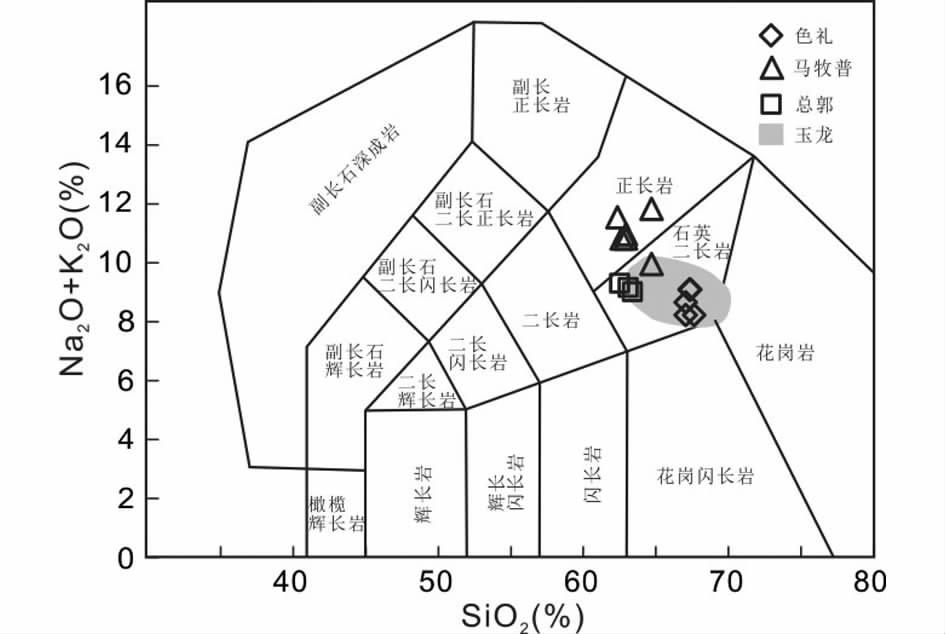
|
图 5 玉龙斑岩铜矿带南段色礼、马牧普和总郭含矿斑岩体TAS图解(据Middlemost,1994) 玉龙含矿斑岩体数据来源于马鸿文,1990; 张玉泉等,1998a; Jiang et al.,2006;图 6同 The data of the Yulong ore-bearing porphyries are from Ma,1990; Zhang et al.,1998a; Jiang et al.,2006; also in the Fig. 6 Fig. 5 TAS plot for the Seli,the Mamupu and the Zongguo ore-bearing porphyries in the southern Yulong porphyry Cu belt(after Middlemost,1994) |

|
图 6 玉龙斑岩铜矿带南段色礼、马牧普和总郭含矿斑岩体SiO2-K2O图解(a)和A/CNK-A/NK图解(b) Fig. 6 SiO2 vs. K2O diagram(a)and A/CNK vs. A/NK diagram(b)for the Seli,the Mamupu and the Zongguo ore-bearing pophyries in the southern Yulong porphyry Cu belt |
色礼二长花岗斑岩,马牧普正长斑岩,总郭石英二长斑岩微量元素原始地幔标准化模式图十分相似,均以相对富集大离子亲石元素,亏损高强场元素(Nb、Ta、P、Ti、Zr、Hf)(图 7a)为特征。3个斑岩体的稀土元素球粒陨石标准化配分模式图也基本一致,呈现明显的右倾型(图 7b),相对富集轻稀土,LREE/HREE比值为17.9~26.2之间,(La/Yb)N比值为37.5~78.2之间,ΣREE含量为217.5×10-6~480.2×10-6之间,无或者非常弱的Eu负异常,Eu/Eu*比值在0.72~0.97之间。玉龙斑岩铜矿带南段含矿斑岩体微量元素特征与北段玉龙含矿斑岩体十分相似(图 7),暗示其具有相似的源区特征。
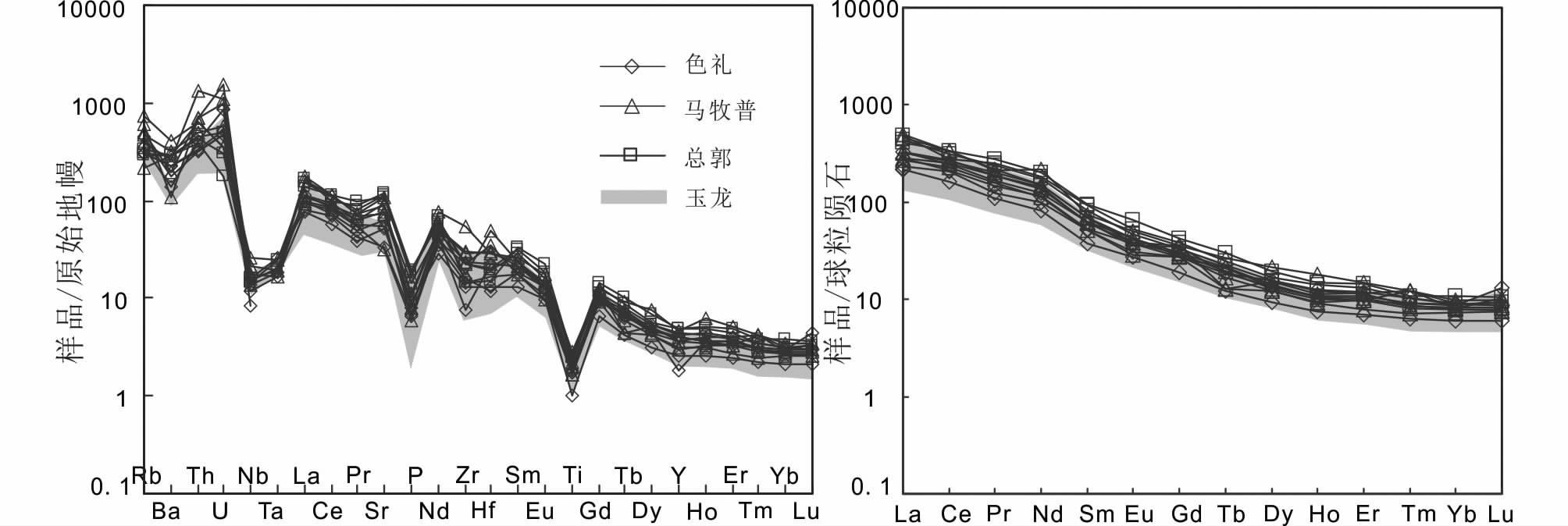
|
图 7 玉龙斑岩铜矿带南段色礼、马牧普和总郭含矿斑岩体原始地幔标准化微量元素蛛网图(a)和球粒陨石标准化稀土元素配分图(b)(标准化值据Sun and McDonough,1989) 玉龙含矿斑岩体数据来源来源于马鸿文,1990; 张玉泉等,1998c; Jiang et al.,2006 The data of the Yulong ore-bearing porphyries are from Ma,1990; Zhang et al.,1998c; Jiang et al.,2006 Fig. 7 Primitive mantle-normalized trace element spiderdiagrams(a)and chondrite-normalized REE patterns(b)of the Seli,the Mamupu and the Zongguo ore-bearing porphyries in the southern Yulong porphyry Cu belt(normalization values after Sun and McDonough,1989) |
|
|
表 2 玉龙斑岩铜矿带南段色礼二长花岗斑岩锆石Hf同位素组成 Table 2 Zircon Hf isotope data for the Seli monzongranite porphyry in the southern Yulong porphyry Cu belt |
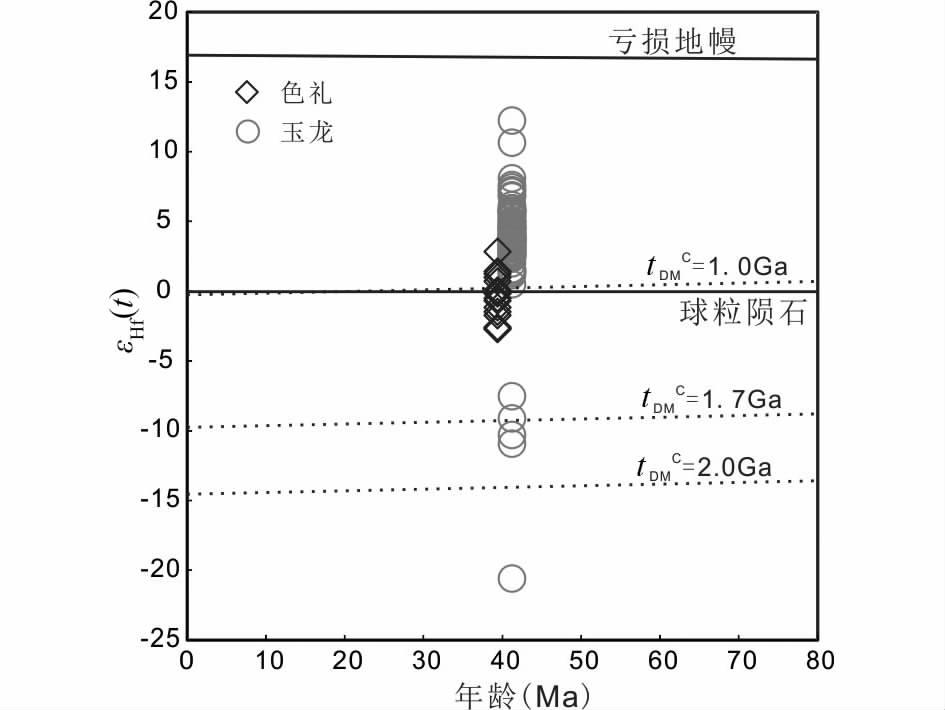
|
图 8 色礼含矿斑岩体及玉龙含矿斑岩体锆石εHf(t)-t图解 玉龙含矿斑岩体数据来源于Jiang et al.,2006和Li et al.,2012,玉龙含矿斑岩体年龄采用41.2Ma(Liang et al.,2006) Data sources: the Yulong ore-bearing porphyry are from Jiang et al.,2006; Li et al.,2012,the age of the Yulong ore-bearing porphyry is based on Liang et al.,2006 Fig. 8 Zircon εHf(t)vs. t plot of the Seli ore-bearing porphyry and the Yulong ore-bearing porphyries |
色礼二长花岗斑岩样品(83-931)中16个有效测点176Lu/177Hf比值在0.001032~0.001901之间,平均值为0.001277。176Hf/177Hf比值在0.282672~0.282828之间,平均值为0.282737。锆石εHf(t)值为-3.6~2.0,平均值为-1.2,tDM为837~606Ma,平均值为735Ma,tDMC为1286~933Ma,平均值为1139Ma。
5 讨论 5.1 玉龙斑岩铜矿带南段含矿岩体的形成时代玉龙铜矿带南段含矿岩体一直缺乏精确的测年工作,前人报道的色礼岩体2个K-Ar年龄分别为101.6Ma(唐仁鲤和罗怀松,1995)及39.5Ma(张玉泉等,1987),马牧普岩体为K-Ar年龄96.8Ma(刘荣谟和赵定华,1981),Rb-Sr年龄为38.0~27.4Ma(唐仁鲤和罗怀松,1995)。这些年龄变化很大,显然不能反映岩体形成时代。锆石抗后期地质热事件干扰能力强,岩浆锆石U-Pb年龄可反映岩浆侵位结晶年龄。锆石CL图像显示具明显的生长环带及其较高的Th/U比值表明分析的锆石为岩浆结晶锆石,锆石LA-ICP-MS U-Pb年龄可反映岩体岩浆结晶时代。因此,玉龙斑岩铜矿带南段色礼二长花岗斑岩形成时代为39.4±0.2Ma(MSWD=1.10),马牧普正长斑岩形成时代为38.5±0.3Ma(MSWD=1.79),总郭石英二长斑岩形成时代为39.4±0.2Ma(MSWD=1.05)。玉龙斑岩铜矿带北段5个主要成矿斑岩体锆石U-Pb年龄从北向南逐渐降低,从玉龙斑岩体的41.2±0.2Ma降低至马拉松多斑岩体的36.9±0.4Ma(Liang et al.,2005)。玉龙斑岩铜矿带南段3个斑岩体锆石LA-ICP-MS U-Pb年龄结果表明位于中部的马牧普斑岩体年龄略小于其两端的色礼和总郭斑岩体年龄,南段3个斑岩体年龄未见从北往南降低的趋势。
5.2 玉龙斑岩铜矿带南段含矿岩体岩浆的源区特征色礼、马牧普和总郭矿化斑岩体主量元素组成上具高碱富钾持征,为钾玄质岩石。目前多认为钾玄质岩石主要来源于受俯冲流体交代的地幔部分熔融(Morrison,1980; Turner et al.,1996; Rogers et al.,1998; Jiang et al.,2002,2005,2006)。玉龙斑岩铜矿带含矿岩体为花岗岩类,硅饱和,因此,其不会直接来自流体交代地幔的部分熔融。Campbell et al.,(2014) 提出陆壳物质的部分熔融可形成硅饱和的钾玄质岩石。色礼、马牧普和总郭岩体微量元素模型以相对亏损Nb、Ta、P、Ti及富集大离子亲石元素为特征,显示壳幔混合源区的一般特征。此外,岩石相对相对富Sr,缺乏明显的Eu负异常,说明源区没有斜长石残留或岩浆没发生过斜长石的分离结晶。而岩体相对亏损HREEs和Y说明源区有石榴石残留相。色礼岩体εHf(t)值在-2.7~2.8之间,在εHf(t)-t图上位于古老地壳和亏损地幔之间(图 8),其tDMC在1286~933Ma之间,显示其主要来自古老地壳部分熔融及混入了少量新生地壳(或亏损地幔)物质。色礼斑岩体、马牧普斑岩体及总郭斑岩体空间相邻,时代相近,主微量元素特征相似,它们应具相同源区特征,因此,玉龙斑岩铜矿带南段三个矿化斑岩体都是由古老地壳部分熔融混入了少量新生地壳(或亏损地幔)物质形成的。
5.3 矿化岩体形成的动力学背景马鸿文(1990) 和芮宗瑶等(1984) 认为玉龙斑岩铜矿带形成于岛弧环境,类似于安第斯斑岩铜矿带。王增等(1995) 认为玉龙斑岩铜矿带形成于陆内环境与走滑断裂系统有关。Hou et al.(2003) 提出由印度-欧亚碰撞诱发的区域性大规模走滑系统控制着新生代49~30Ma斑岩体的分布。Liang et al.(2006) 据玉龙斑岩铜矿带北段主要成矿岩体从北往南锆石年龄逐渐降低及岩体地球化学特征,提出,玉龙斑岩铜矿带受大规模左行走滑及局部俯冲控制。由于欧亚板块在65Ma左右发生碰撞(Yin and Harrison,2000),在藏东诱发红河-哀牢山左行走滑深大断裂。该深大断裂走向北东,长度超过1000km,左行走滑错距700~200km,切穿岩石圈地幔(Leloup et al.,1995)。
据玉龙斑岩铜矿带南段含矿斑岩体形成时代及区内构造背景、矿化岩体源区特征,我们认为玉龙斑岩铜矿带南段矿化斑岩体形成构造背景和玉龙北段矿化斑岩体相似,都和区内左行走滑深大断裂活动有关。切穿岩石圈地幔的深大断裂活动会引起软流圈上涌,且已有地球物理资料表明,该区域深大断裂带莫霍面比周围地区高2~3km(费鼎,1983; 唐仁鲤和罗怀松,1995),也显示软流圈上涌。左行走滑深大断裂发生数百千米水平错移时,局部俯冲会把下部陆壳推入沿断裂带上涌的岩石圈地幔之中(Campbell et al.,2014)。这些地壳物质被上涌的软流圈地幔加热发生部分熔融及混染部分岩石圈地幔物质,便形成了具壳幔混合源区特征的斑岩岩浆。因此,玉龙斑岩铜矿带矿化岩体及相关斑岩矿床的形成和印度-欧亚板块碰撞诱发的切穿岩石圈深大断裂活动引致的软流圈上涌有关。
5.4 玉龙斑岩铜矿带南段和北段成矿规模差异分析玉龙斑岩铜矿带南段和北段成矿规模差异明显,超大型、大型矿床主要集中于北段,目前南段矿化规模不大,多为矿化点,是什么原因导致玉龙斑岩铜矿带南段和北段成矿规模明显不同?
玉龙斑岩铜矿带北段玉龙含矿岩体和南段主要矿化斑岩体主量元素特征相似(图 5、图 6),微量元素及稀土元素特征(图 7)也基本相似,显示相似的源区特征。前人研究表明,富水高氧化岩浆有利于铜金钼等成矿元素在岩浆形成演化过程中富集,形成矿床(Ballard et al.,2002; Halter et al.,2002; Mungall,2002; Jugo et al.,2005; Liang et al.,2006; Sun et al.,2013,2015)。同时实验研究表明,铜金钼等成矿元素在流体和熔体之间的分配系数较大,岩浆出溶挥发相后,成矿元素便主要集中于挥发相中,且富水岩浆通常较早出溶挥发相,较早出溶挥发相的岩浆有利于金属元素的富集,进而成矿(Chiaradia et al.,2012)。总郭斑岩体(83-85)成矿早期见磁铁矿-赤铁矿组合(图 9d),指示岩浆具有高氧逸度(Liang et al.,2009)。色礼、马牧普和总郭这3个斑岩体见角闪石斑晶(图 9a-c),且均具较高的Sr/Y比值(48~120),表明赋矿斑岩体岩浆富水(Richard,2011; Alonso-Perez et al.,2009; Chiaradia et al.,2012)。色礼、马牧普斑岩体石英斑晶中见大量流体包裹体(图 10a,b),说明岩浆较早出溶挥发相(Chiaradia et al.,2012)。色礼、马牧普斑岩体中石英斑晶中流体包裹体的液相成分和气相成分都以水为主(图 10a1,a2,b1,b2),显示岩浆出溶挥发相以水为主,也进一步说明岩浆富水。前人研究玉龙斑岩铜矿带北段矿化岩体也都具有富水高氧逸度的特征(Jiang et al.,2006; Liang et al.,2006,2009)。因此,玉龙斑岩铜矿带北段和南段矿化岩体都具高氧化富水特征,都有利于成矿元素在岩浆形成演化过程中富集成矿。那么为什么玉龙矿带北段矿化规模很大,南段矿化规模很小?对比北段玉龙超大型斑岩铜矿床和南段色礼斑岩矿化点矿化斑岩体锆石Hf同位素组成发现,玉龙斑岩铜矿床矿化岩体锆石具较高的εHf(t)值(Jiang et al.,2006; Li et al.,2012)(图 8),如不考虑其中5个较大负值异常点(推测可能为继承锆石的值,因为笔者在玉龙斑岩体中发现印支期继承锆石),则其εHf(t)平均值在4.2左右,大于色礼含矿斑岩体εHf(t)平均值(-0.4)。岩体锆石εHf(t)值较高,显示其岩浆源区含更多新生地壳物质或者亏损地幔物质。此外,玉龙斑岩铜矿床伴生Au(氧化次生富集带Au含量可达4×10-6)和铂族元素(伴生铂族元素储量达中型规模)(唐仁锂和罗怀松,1995),也进一步表明其含矿岩浆来自深源,岩浆源区具有较多幔源物质。因此,玉龙超大型斑岩矿床成矿岩体比色礼矿床(点)含矿斑岩体的岩浆源区含有更多新生地壳物质或亏损地幔物质。玉龙斑岩铜矿带南段和北段成矿规模的差异,可能和岩浆含有更多的新生地壳物质或亏损地幔物质有关。结合前人研究,陆壳Cu平均含量为27×10-6(Rudnick and Gao,2014),MORB的Cu含量可以达到70×10-6~150×10-6(Hofmann,1988; Sun et al.,2003),说明地幔中Cu含量远高于陆壳;并且Cu为中等不相容元素,Cu在壳幔分异过程中倾向进入地幔。因此,含更多新生地壳或亏损地幔物质的岩浆更加富集Cu等成矿元素,更有利于于形成大型超大型斑岩型矿床。

|
图 9 色礼二长花岗斑岩中(a)、马牧普正长斑岩中(b)、总郭石英二长斑岩中(c)的角闪石斑晶及总郭石英二长斑岩中磁铁矿与赤铁矿交生图(d) Amph-角闪石;Mt-磁铁矿;Hem-赤铁矿.色礼二长花岗斑岩中角闪石斑晶发生了黑云母化 Amph-amphibole; Mt-magnetite; Hem-hematite. 色礼二长花岗斑岩中角闪石斑晶发生了黑云母化 Fig. 9 Microphotos of amphibole phenocryst in the Seli monzongranite porphyry(a),the Mamupu syenite porphyry(b),the Zongguo quartz monzongranite porphyry(c)and the hematite and magnetite intergrowths of the Zongguo quartz monzongranite porphyry(d) |
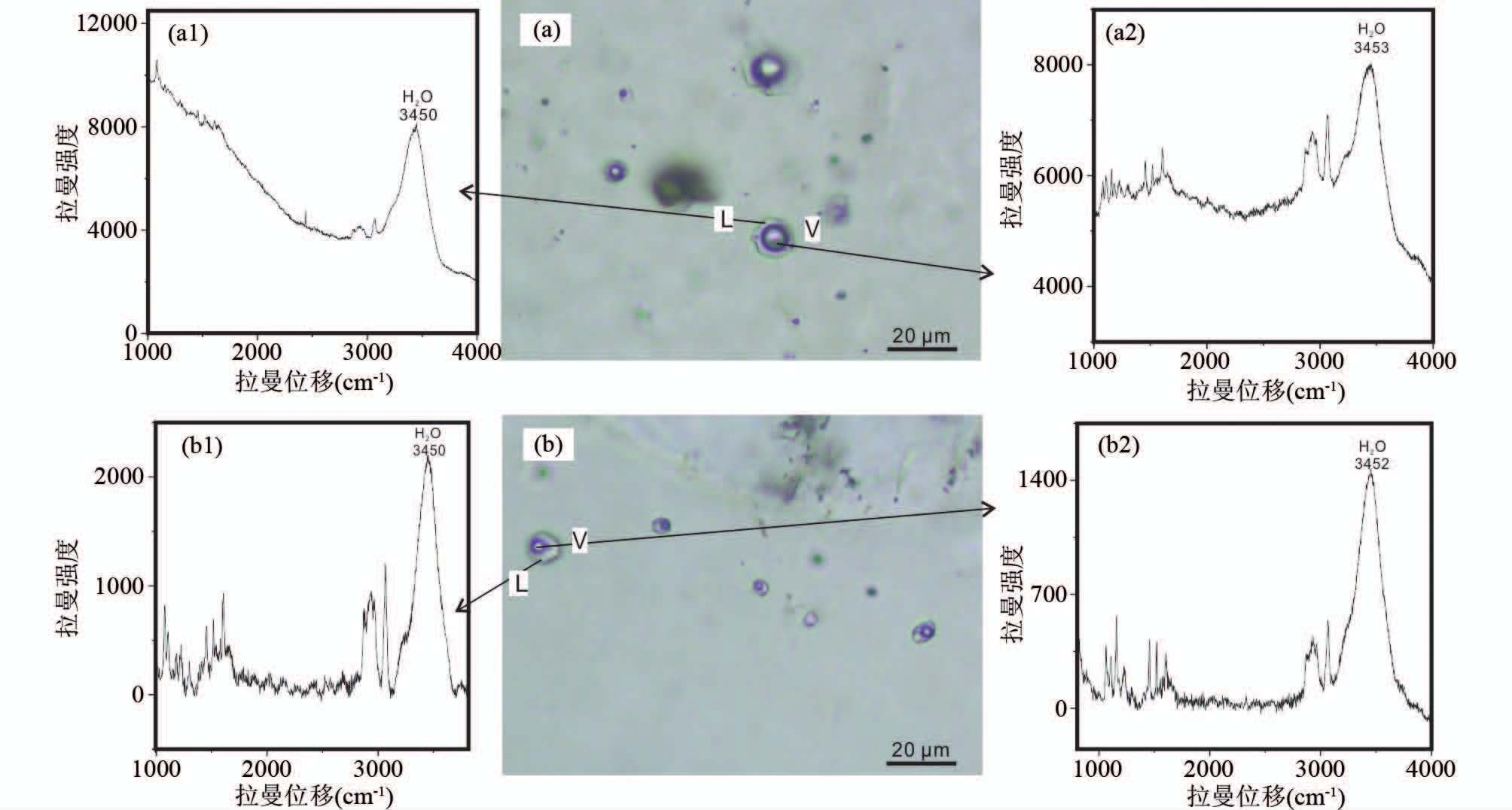
|
图 10 色礼二长花岗斑岩(a、a1、a2)和马牧普正长斑岩(b、b1、b2)中石英斑晶中流体包裹体特征及包裹体激光拉曼光谱分析 Fig. 10 Microphotographs of fluid inclusions and laser Raman spectra of fluid inclusions in quartz phenocryst in the Seli monzongranite porphyry(a,a1,a2)and the Mamupu syenite porphyry(b,b1,b2) |
综上,我们可得出以下主要结论:
(1) 玉龙斑岩铜矿带南段色礼二长花岗斑岩、马牧普正长斑岩和总郭石英二长斑岩锆石LA-ICP-MS U-Pb年龄分别为39.4±0.2Ma、38.5±0.3Ma和39.4±0.2Ma。位于中部的马牧普斑岩体锆石LA-ICP-MS U-Pb年龄略小于两端的色礼和总郭斑岩体锆石U-Pb年龄。
(2) 色礼、马牧普和总郭斑岩矿床(点)形成和印度板块与欧亚板块碰撞诱发的走滑深大断裂活动有关。含矿斑岩体主要由古老陆壳的部分熔融形成,有少量幔源或新生地壳物质的混入。
(3) 玉龙斑岩铜矿带南段和北段矿化岩体εHf(t)值明显不同,北段玉龙超大型矿床成矿岩体εHf(t)值较大,南段色礼矿化点斑岩体εHf(t)值较小。玉龙斑岩铜矿带南段和北段矿化规模巨大差异可能和含矿斑岩体岩浆源区中混入新生地壳物质(或亏损地幔物质)比例高低有关。
致谢 野外工作期间西藏地质矿产局第一地质大队给予了大力协助;澳大利亚国立大学地球科学研究院ICP-MS实验室和Charllote Allen在实验工作中给予了大力支持;在此一并致谢。| [1] | Alonso-Perez R, Müntener O, Ulmer P. 2009. Igneous garnet and amphibole fractionation in the roots of island arcs:Experimental constraints on andesitic liquids. Contributions to Mineralogy and Petrology , 157 (4) :541–558. |
| [2] | Ballard JR. 2001. A comparative study between the geochemistry of ore-bearing and barren calc-alkaline intrusions. Ph. D. Dissertation. Canberra:Australian National University, 1-250 |
| [3] | Ballard JR, Palin JM, Campbell IH. 2002. Relative oxidation states of magmas inferred from Ce(Ⅳ)/Ce(Ⅲ) in zircon:Application to porphyry copper deposits of northern Chile. Contributions to Mineralogy and Petrology , 144 (3) :347–364. |
| [4] | Blichert-Toft J, Albarède F. 1997. The Lu-Hf isotope geochemistry of chondrites and the evolution of the mantle-crust system. Earth and Planetary Science Letters , 148 (1-2) :243–258. |
| [5] | Campbell IH, Stepanov AS, Liang HY, Allen CM, Norman MD, Zhang YQ, Xie YW. 2014. The origin of shoshonites:New insights from the Tertiary high-potassium intrusions of eastern Tibet. Contributions to Mineralogy and Petrology , 167 :983. |
| [6] | Chen WM. 2001. Genetic relation between deep-seated alkali-rich hydrothermal fluids and ore-bearing porphyries of porphyry copper deposits:Evidence from fluid inclusions and phenocryst textures. Earth Science Frontiers , 8 (4) :409–412. |
| [7] | Chiaradia M, Ulianov A, Kouzmanov K, Beate B. 2012. Why large porphyry Cu deposits like high Sr/Y magmas?. Scientific Reports , 2 :685. |
| [8] | Deng J, Wang QF, Li GJ, Santosh M. 2014. Cenozoic tectono-magmatic and metallogenic processes in the Sanjiang region, southwestern China. Earth-Science Reviews , 138 :268–299. |
| [9] | Deng J, Wang CM, Li WC, Yang LQ, Wang QF. 2014. The situation and enlightenment of the research of the tectonic evolution and metallogenesis in the Sanjiang Tethys. Earth Science Frontiers , 21 (1) :52–64. |
| [10] | Ding CJ, Wang Z, Shentu BY.1990. A Nd-Sr study of major mineralizing rockbodies in Yulong porphyry Cu (Mo) belt, eastern Xizang (Tibet). In: Contribution to the Geology of the Qinghai-Xizang (Tibet) Plateau (20). Beijing:The Geological Society of China : 160 -167. |
| [11] | Fei D. 1983. On the structural feature and the oceanization in the north part of South China Sea. Acta Geophysica Sinica , 26 (5) :459–467. |
| [12] | Griffin WL, Pearson NJ, Belousova E, Jackson SE, van Achterbergh E, O'Reilly SY, Shee SR. 2000. The Hf isotope composition of cratonic mantle:LAM-MC-ICPMS analysis of zircon megacrysts in kimberlites. Geochimica et Cosmochimica Acta , 64 (1) :133–147. |
| [13] | Griffin WL, Wang X, Jackson SE, Pearson NJ, O'Reilly SY, Xu XS, Zhou XM. 2002. Zircon chemistry and magma mixing, SE China:In-situ analysis of Hf isotopes, Tonglu and Pingtan igneous complexes. Lithos , 61 (3-4) :237–269. |
| [14] | Halter WE, Pettke T, Heinrich CA. 2002. The origin of Cu/Au ratios in porphyry-type ore deposits. Science , 296 (5574) :1844–1846. |
| [15] | Harris AC, Allen CM, Bryan SE, Campbell IH, Holcombe RJ, Palin JM. 2004. ELA-ICP-MS U-Pb zircon geochronology of regional volcanism hosting the Bajo de la Alumbrera Cu-Au deposit:Implications for porphyry-related mineralization. Mineralium Deposita , 39 (1) :46–67. |
| [16] | He GC, Wang GQ, Huang WT, Zou YQ, Wu J, Liang HY, Zhang YQ, Allen CM. 2014. Zircon LA-ICP-MS U-Pb age of the Zalaga porphyry associated with Cu-Mo mineralization in the Yulong ore belt and its geological implication. Geochimica , 43 (4) :399–407. |
| [17] | Hofmann AW. 1988. Chemical differentiation of the Earth:The relationship between mantle, continental crust, and oceanic crust. Earth and Planetary Science Letters , 90 (3) :297–314. |
| [18] | Horn I, Rudnick RL, McDonough WF. 2000. Precise elemental and isotope ratio determination by simultaneous solution nebulization and laser ablation-ICP-MS:Application to U-Pb geochronology. Chemical Geology , 164 (3-4) :281–301. |
| [19] | Hoskin PWO, Black LP. 2000. Metamorphic zircon formation by solid-state recrystallization of protolith igneous zircon. Journal of Metamorphic Geology , 18 (4) :423–439. |
| [20] | Hou ZQ, Ma HW, Zaw K, Zhang YQ, Wang MJ, Wang Z, Pan GT, Tang RL. 2003. The Himalayan Yulong porphyry copper belt:Product of large-scale strike-slip faulting in eastern Tibet. Economic Geology , 98 (1) :125–145. |
| [21] | Jiang YH, Jiang SY, Ling HF, Zhou XR, Rui XJ, Yang WZ. 2002. Petrology and geochemistry of shoshonitic plutons from the western Kunlun orogenic belt, Xinjiang, northwestern China:Implications for granitoid geneses. Lithos , 63 (3-4) :165–187. |
| [22] | Jiang YH, Ling HF, Jiang SY, Fan HH, Shen WZ, Ni P. 2005. Petrogenesis of a Late Jurassic peraluminous volcanic complex and its high-Mg, potassic, quenched enclaves at Xiangshan, southeast China. Journal of Petrology , 46 (6) :1121–1154. |
| [23] | Jiang YH, Jiang SY, Ling HF, Dai BZ. 2006. Low-degree melting of a metasomatized lithospheric mantle for the origin of Cenozoic Yulong monzogranite-porphyry, East Tibet:Geochemical and Sr-Nd-Pb-Hf isotopic constraints. Earth and Planetary Science Letters , 241 (3-4) :617–633. |
| [24] | Jiang YH, Jiang SY, Ling HF, Dai BZ. 2006a. Petrogenesis of Cu-bearing porphyry associated with continent-continent collisional setting:Evidence from the Yulong porphyry Cu ore-belt, East Tibet. Acta Petrologica Sinica , 22 (3) :697–706. |
| [25] | Jiang YH, Jiang SY, Dai BZ, Ling HF. 2006b. Comparison on elemental and isotopic geochemistry of ore-bearing and barren porphyries from the Yulong porphyry Cu deposit, East Tibet. Acta Petrologica Sinica , 22 (10) :2561–2566. |
| [26] | Jugo PJ, Luth RW, Richards JP. 2005. Experimental data on the speciation of sulfur as a function of oxygen fugacity in basaltic melts. Geochimica et Cosmochimica Acta , 69 (2) :497–503. |
| [27] | Leloup PH, Lacassin R, Tapponnier P, Schärer U, Zhong DL, Liu XH, Zhang LS, Ji SC, Trinh PT. 1995. The Ailao Shan-Red River shear zone (Yunnan, China), Tertiary transform boundary of Indochina. Tectonophysics , 251 (1-4) :3–84. |
| [28] | Li JX, Qin KZ, Li GM, Cao MJ, Xiao B, Chen L, Zhao JX, Evans NJ, McInnes BIA. 2012. Petrogenesis and thermal history of the Yulong porphyry copper deposit, eastern Tibet:Insights from U-Pb and U-Th/He dating, and zircon Hf isotope and trace element analysis. Mineralogy and Petrology , 105 (3-4) :201–221. |
| [29] | Li XH. 1997. Geochemistry of the Longsheng ophiolite from the southern margin of Yangtze Craton, SE China. Geochemical Journal , 31 (5) :323–337. |
| [30] | Li XH, Qi CS, Liu Y, Liang XR, Tu XL, Xie LW, Yang YH. 2005. Petrogenesis of the Neoproterozoic bimodal volcanic rocks along the western margin of the Yangtze Block:New constraints from Hf isotopes and Fe/Mn ratios. Chinese Science Bulletin , 50 (21) :2481–2486. |
| [31] | Li XH, Long WG, Li QL, Liu Y, Zheng YF, Yang YH, Chamberlain KR, Wan DF, Guo CH, Wang XC, Tao H. 2010. Penglai zircon megacrysts:A potential new working reference material for microbeam determination of Hf-O isotopes and U-Pb age. Geostandards and Geoanalytical Research , 34 (2) :117–134. |
| [32] | Li YQ, Rui ZY, Cheng LX. 1981. Fluid inclusions and mineralization of the Yulong porphyry copper (molybdenum) deposit. Acta Geologica Sinica , 55 (3) :216–231. |
| [33] | Liang HY, Zhang YQ, Xie YW, Lin W, Campbell IH, Yu HX.2005. Geochronological and geochemical study on the Yulong porphyry copper ore belt in eastern Tibet, China. In:Mineral Deposit Research:Meeting the Global Challenge. . Berlin Heidelberg: Springer : 1235 -1237. |
| [34] | Liang HY, Campbell IH, Allen C, Sun WD, Liu CQ, Yu HX, Xie YW, Zhang YQ. 2006. Zircon Ce4+/Ce3+ ratios and ages for Yulong ore-bearing porphyries in eastern Tibet. Mineralium Deposita , 41 (2) :152–159. |
| [35] | Liang HY, Mo JH, Sun WD, Yu HX, Zhang YQ, Allen CM. 2008. Study on the duration of the ore-forming system of the Yulong giant porphyry copper deposit in eastern Tibet, China. Acta Petrologica Sinica , 24 (10) :2352–2358. |
| [36] | Liang HY, Sun WD, Su WC, Zartman RE. 2009. Porphyry copper-gold mineralization at Yulong, China, promoted by decreasing redox potential during magnetite alteration. Economic Geology , 104 (4) :587–596. |
| [37] | Liang HY, Mo JH, Sun WD, Zhang YQ, Zeng T, Hu GQ, Allen CM. 2009. Study on geochemical composition and isotope ages of the Malasongduo porphyry associated with Cu-Mo mineralization. Acta Petrologica Sinica , 25 (2) :385–392. |
| [38] | Liu RM, Zhao DH. 1981. A discussion on the isotopic ages of the intrusive rocks in eastern Xizang (Tibet), China. Geological Review , 27 (4) :326–332. |
| [39] | Lü BX, Wang Z, Zhang ND, Duan JZ, Gao ZY, Shen GF, Pan CY, Yao P.1993. Granitic Rocks and Their Metallogenic Specialization in the Sanjiang Area, China. Beijing: Geological Publishing House : 1 -330. |
| [40] | Ma HW. 1989. Emplacement age of granitic magma in the Yulong porphyry copper belt, eastern Tibet. Geochimica (3) :210–216. |
| [41] | Ma HW.1990. Granitoid and Mineralization of the Yulong Porphyry Copper Belt in Eastern Tibet. Wuhan: China University of Geosciences Press : 1 -158. |
| [42] | Middlemost EAK. 1994. Naming materials in the magma/igneous rock system. Earth-Science Reviews , 37 (3-4) :215–224. |
| [43] | Morrison GW. 1980. Characteristics and tectonic setting of the shoshonite rock association. Lithos , 13 (1) :97–108. |
| [44] | Mungall JE. 2002. Roasting the mantle:Slab melting and the genesis of major Au and Au-rich Cu deposits. Geology , 30 (10) :915–918. |
| [45] | Richards JP. 2011. High Sr/Y arc magmas and porphyry Cu±Mo±Au deposits:Just add water. Economic Geology , 106 (7) :1075–1081. |
| [46] | Rogers NW, James D, Kelley SP, De Mulder M. 1998. The generation of potassic lavas from the eastern Virunga Province, Rwanda. Journal of Petrology , 39 (6) :1223–1247. |
| [47] | Rudnick RL, Gao S.2014. >Composition of the continental crust. In:Rudnick RL (ed.). Treatise on Geochemistry. .2nd Edition. Oxford: Elsevier : 1 -51. |
| [48] | Rui ZY, Huang CK, Qi GM.1984. Porphyry Copper (Molybdenum) Deposits in China. Beijing: Geological Publishing House : 1 -350. |
| [49] | Söderlund U, Patchett PJ, Vervoort JD, Isachsen CE. 2004. The 176Lu decay constant determined by Lu-Hf and U-Pb isotope systematics of Precambrian mafic intrusions. Earth and Planetary Science Letters , 219 (3-4) :311–324. |
| [50] | Sun MY, Qu HC, Li QY, Zhou LM, Yang ZM, Liu ST, Liu YG. 2015. Recognition of the ore-forming porphyry in the Yulong Cu deposit and its geological significance. Acta Petrologica et Mineralogica , 34 (4) :493–504. |
| [51] | Sun SS, McDonough WF. 1989. Chemical and isotopic systematics of oceanic basalts:Implications for mantle composition and processes. In:Saunders AD and Norry MJ (eds.). Magmatism in the Ocean Basins. Geological Society, London, Special Publication , 42 (1) :313–345. |
| [52] | Sun W, Bennett VC, Eggins SM, Arculus RJ, Perfit MR. 2003. Rhenium systematics in submarine MORB and back-arc basin glasses:Laser ablation Icp-Ms results. Chemical Geology , 196 (1-4) :259–281. |
| [53] | Sun WD, Liang HY, Ling MX, Zhan MZ, Ding X, Zhang H, Yang XY, Li YL, Ireland TR, Wei QR, Fan WM. 2013. The link between reduced porphyry copper deposits and oxidized magmas. Geochimica et Cosmochimica Acta , 103 :263–275. |
| [54] | Sun WD, Huang RF, Li H, Hu YB, Zhang CC, Sun SJ, Zhang LP, Ding X, Li CY, Zartman RE, Ling MX. 2015. Porphyry deposits and oxidized magmas. Ore Geology Reviews , 65 :97–131. |
| [55] | Tang RL, Luo HS.1995. The Geology of Yulong Porphyry Copper (Molybdenum) Ore Belt, Xizang (Tibet). Beijing: Geological Publishing House : 1 -320. |
| [56] | Turner S, Arnaud N Liu J, Rogers N, Hawkesworth C, Harris N, Kelley S, Van Calsteren P, Deng W. 1996. Post-collision, shoshonitic volcanism on the Tibetan Plateau:Implications for convective thinning of the lithosphere and the source of ocean island basalts. Journal of Petrology , 37 (1) :45–71. |
| [57] | Wang Z, Shentu BY, Ding CJ, Yao P, Geng QR.1995. Granitoid and Its Mineralization East of Tibet, China. Chengdu: Publishing House of the Southwestern University of Communication : 1 -150. |
| [58] | Wu FY, Yang YH, Xie LW, Yang JH, Xu P. 2006. Hf isotopic compositions of the standard zircons and baddeleyites used in U-Pb geochronology. Chemical Geology , 234 (1-2) :105–126. |
| [59] | Wu WZ, Xia B, Zhang YQ, Dong BH, Xia ZX. 2013. Geochemical characteristics and metallogenic mechanism of the porphyry Cu-Mo deposits in the Yulong Ore Belt, eastern Tibet:A case study of the Yulong and Duoxiasongduo porphyries. Geotectonica et Metallogenia , 37 (3) :440–454. |
| [60] | Yin A, Harrison TM. 2000. Geologic evolution of the Himalayan-Tibetan orogen. Annual Review of Earth and Planetary Sciences , 28 :211–280. |
| [61] | Zhang SM, Xiao YF, Gong TT, He JL, Wang Q, Zhang L, Sun JD. 2012. Optimal selection assessment on geochemical anomalies at Gegongnong, Hengxingcuo, Mamupu in the Yulong metallogenic zone, Tibet. Bulletin of Mineralogy, Petrology and Geochemistry , 31 (4) :354–360. |
| [62] | Zhang YQ, Xie YW, Tu GC. 1987. Preliminary studies of the alkali-rich intrusive rocks in the Ailaoshan-Jinshajiang belt and their bearing on rift tectonics. Acta Petrologica Sinica , 3 (1) :17–25. |
| [63] | Zhang YQ, Xie YW, Liang HY, Qiu HN, Li XH, Zhong SL. 1998a. Petrogenesis series and the ore-bearing porphyries of the Yulong copper ore belt in eastern Tibet. Geochimica , 27 (3) :236–243. |
| [64] | Zhang YQ, Xie YW, Qiu HN, Li XH, Zhong SL. 1998b. Shoshonitic series:Sr, Nd and Pb isotopic compositions of ore-bearing porphyry for Yulong copper ore belt in the eastern Xizang (Tibet). Scientia Geologica Sinica , 33 (3) :359–366. |
| [65] | Zhang YQ, Xie YW, Qiu HN, Li XH, Zhong SL. 1998c. Shoshonitic series:Geochemical characteristics of elements for ore-bearing porphyry from Yulong copper ore belt in eastern Tibet. Earth Science , 23 (6) :557–561. |
| [66] | 陈文明.2001. 深源富碱硅热流体与斑岩铜矿含矿斑岩体的成因联系及流体包裹体、斑晶结构证据. 地学前缘 , 8 (4) :409–421. |
| [67] | 邓军, 王长明, 李文昌, 杨立强, 王庆飞.2014. 三江特提斯复合造山与成矿作用研究态势及启示. 地学前缘 , 21 (1) :52–64. |
| [68] | 丁朝建, 王增, 申屠保涌. 1990. 藏东玉龙斑岩铜(钼)矿带主要成矿岩体Nd-Sr同位素特征. 见:青藏高原地质文集(20)——"三江"论文专辑. 北京:中国地质学会, 160-167 |
| [69] | 费鼎.1983. 南海北部区域构造和陆壳向洋壳的转化. 地球物理学报 , 26 (5) :459–467. |
| [70] | 何国朝, 王广强, 黄文婷, 邹银桥, 伍静, 梁华英, 张玉泉, AllenCM.2014. 藏东玉龙斑岩铜矿带扎拉尕含矿斑岩体锆石U-Pb年龄及其地质意义. 地球化学 , 43 (4) :399–407. |
| [71] | 姜耀辉, 蒋少涌, 凌洪飞, 戴宝章.2006a. 陆-陆碰撞造山环境下含铜斑岩岩石成因——以藏东玉龙斑岩铜矿带为例. 岩石学报 , 22 (3) :697–706. |
| [72] | 姜耀辉, 蒋少涌, 戴宝章, 凌洪飞.2006b. 玉龙斑岩铜矿含矿与非含矿斑岩元素和同位素地球化学对比研究. 岩石学报 , 22 (10) :2561–2566. |
| [73] | 李荫清, 苪宗瑶, 程莱仙.1981. 玉龙斑岩铜(钼)矿床的流体包裹体及成矿作用研究. 地质学报 , 55 (3) :216–231. |
| [74] | 梁华英, 莫济海, 孙卫东, 喻亨祥, 张玉泉, AllenCM.2008. 藏东玉龙超大型斑岩铜矿床成岩成矿系统时间跨度分析. 岩石学报 , 24 (10) :2352–2358. |
| [75] | 梁华英, 莫济海, 孙卫东, 张玉泉, 曾提, 胡光黔, AllenCM.2009. 玉龙铜矿带马拉松多斑岩体岩石学及成岩成矿系统年代学分析. 岩石学报 , 25 (2) :385–392. |
| [76] | 刘荣谟, 赵定华.1981. 西藏东部中酸性侵入岩同位素年龄讨论. 地质论评 , 27 (4) :326–332. |
| [77] | 吕伯西, 王增, 张能德, 段建中, 高子英, 沈敢富, 潘长云, 姚鹏. 1993. 三江地区花岗岩类及其成矿专属性. 北京: 地质出版社 : 1 -330. |
| [78] | 马鸿文.1989. 论藏东玉龙斑岩铜矿带岩浆侵入时代. 地球化学 (3) :210–216. |
| [79] | 马鸿文. 1990. 西藏玉龙斑岩铜矿带花岗岩类与成矿. 武汉: 中国地质大学出版社 : 1 -158. |
| [80] | 芮宗瑶, 黄崇轲, 齐国明. 1984. 中国斑岩铜(钼)矿床. 北京: 地质出版社 : 1 -350. |
| [81] | 孙茂妤, 曲焕春, 李秋耘, 周利敏, 杨志明, 刘申态, 刘永刚.2015. 西藏玉龙铜矿床成矿斑岩的厘定及地质意义. 岩石矿物学杂志 , 34 (4) :493–504. |
| [82] | 唐仁鲤, 罗怀松. 1995. 西藏玉龙斑岩铜(钼)矿带地质. 北京: 地质出版社 : 1 -320. |
| [83] | 王增, 申屠保涌, 丁朝建, 姚鹏, 耿全如. 1995. 藏东花岗岩类及其成矿作用. 成都: 西南交通大学出版社 : 1 -150. |
| [84] | 吴伟中, 夏斌, 张玉泉, 董冰华, 夏中曦.2013. 西藏玉龙成矿带斑岩Cu-Mo矿床地质地球化学特征及成矿机制探讨——玉龙和多霞松多对比研究. 大地构造与成矿学 , 37 (3) :440–454. |
| [85] | 张世铭, 肖渊甫, 龚婷婷, 何佳乐, 王强, 张林, 孙建东.2012. 西藏玉龙成矿带各贡弄、恒星错、马牧普地球化学异常优选评价. 矿物岩石地球化学通报 , 31 (4) :354–360. |
| [86] | 张玉泉, 谢应雯, 涂光炽.1987. 哀牢山-金沙江富碱侵入岩及其与裂谷构造关系初步研究. 岩石学报 , 3 (1) :17–25. |
| [87] | 张玉泉, 谢应雯, 梁华英, 邱华宁, 李献华, 钟孙霖.1998a. 藏东玉龙铜矿带含矿斑岩及成岩系列. 地球化学 , 27 (3) :236–243. |
| [88] | 张玉泉, 谢应雯, 邱华宁, 李献华, 钟孙霖.1998b. 钾玄岩系列:藏东玉龙铜矿带含矿斑岩Sr、Nd、Pb同位素组成. 地质科学 , 33 (3) :359–366. |
| [89] | 张玉泉, 谢应雯, 邱华宁, 李献华, 钟孙霖.1998c. 钾玄岩系列:藏东玉龙铜矿带含矿斑岩元素地球化学特征. 地球科学 , 23 (6) :557–561. |
 2016, Vol. 32
2016, Vol. 32


